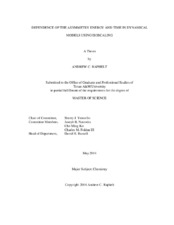| dc.description.abstract | The asymmetry energy (Esym) term of the equation of state for nuclear matter has been studied using fragment distributions and isoscaling. Reactions of ^(64)Ni+^(64)Ni, ^(64)Zn+^(64)Zn, and ^(70)Zn+^(70)Zn were investigated at the Texas A&M University Cyclotron Institute using the NIMROD-ISiS array to collect the data. The same reactions were simulated using anti-symmetrized molecular dynamics (AMD), constrained molecular dynamics (CoMD), and GEMINI, a statistical decay model, used as an afterburner for the dynamical models. The dynamical models were studied at time-steps, or maximum times, of 300 fm/c and 3000 fm/c. In the AMD simulations, GEMINI was applied at 300 fm/c to de-excite the system. The fragment distributions and isoscaling exhibit a dependence on the time-step of the simulation, due to the differences in de-excitation of the system, as well as the E_(sym) of the interactions in AMD and CoMD.
Charge and mass distributions, isotope distributions, and multiplicity distributions were analyzed for the AMD and CoMD simulations and experimental data. The fragment distributions showed a dependence on the time-step of the simulation as well as the E_(sym) of the simulations. The isoscaling also exhibited both time and Esym dependence in the simulations. The dependence on isoscaling with time is not affected by the use of GEMINI as an afterburner, as compared to allowing the system to de-excite dynamically.
Quasi-projectiles (QP) were reconstructed from the simulations and experimental data. The fragments from the QP were studied using the same fragment distributions and isoscaling as in the inclusive data. The fragment distributions were less affected by the time-step of the simulation compared to the fragments before reconstruction, and did not show a large dependence on E_(sym). The QP isoscaling exhibited an E_(sym) dependence and a time-step dependence. The isoscaling results for the AMD simulations are not affected by a dynamical de-excitation compared to a statistical de-excitation.
In the isoscaling analysis, the experimental data agree well with the simulations at later time-steps. The agreement of the simulations with the experimental data is not dependent on the use of a dynamical or statistical model to de-excite the system. The experimental data and simulations in this work are also compared with previous work and the results and conclusions are consistent with the previous results. | en |


